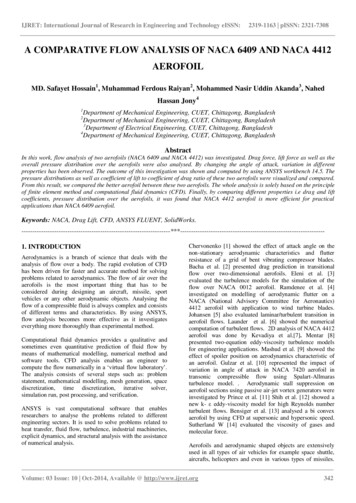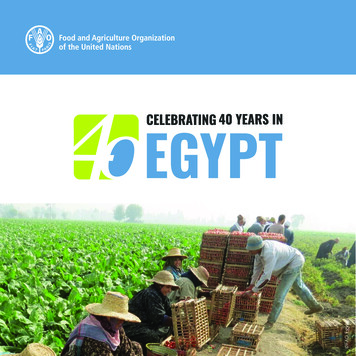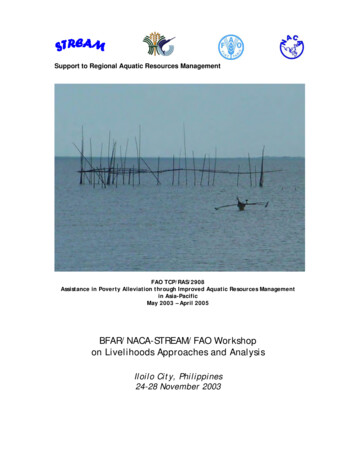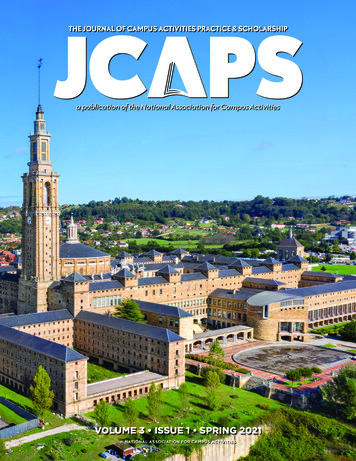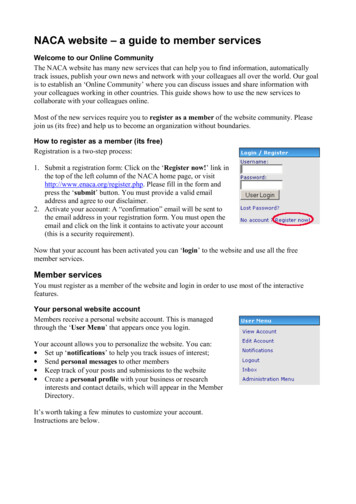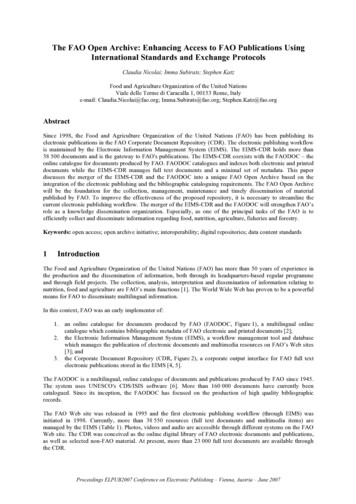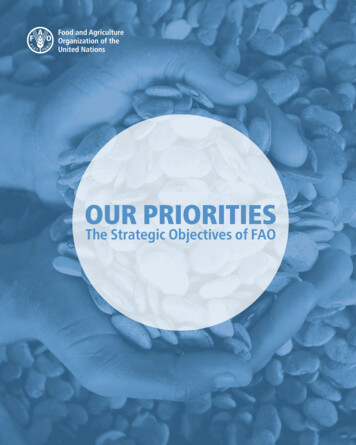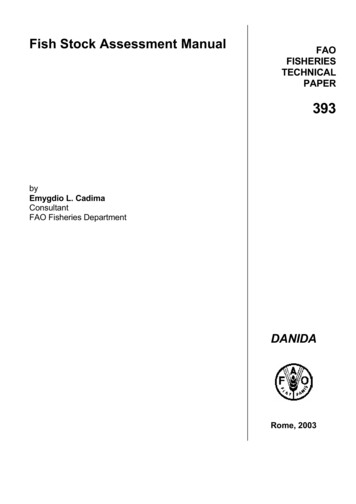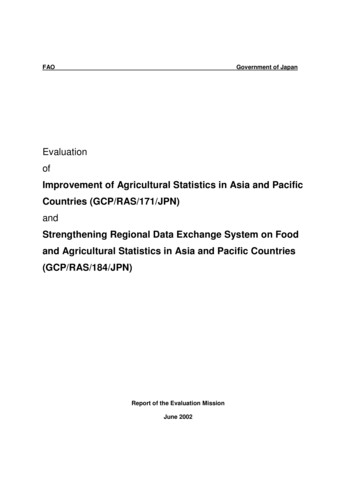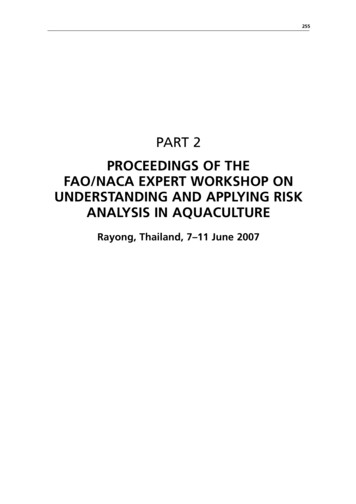
Transcription
255PART 2Proceedings of theFAO/NACA expert workshop onunderstanding and applying riskanalysis in aquacultureRayong, Thailand, 7–11 June 2007
257Proceedings of the FAO/NACAExpert Workshop onUnderstanding and Applying RiskAnalysis in AquacultureRayong, Thailand, 7–11 June 2007BackgroundAs a food-producing sector, aquaculture has surpassed both capture fisheries and theterrestrial farmed meat production systems in terms of average annual growth rate.However, it has a number of biosecurity concerns that pose risks and hazards to bothits development and management, and to the aquatic environment and society.Aquaculture faces risks similar to those of the agriculture sector. However, asaquaculture is very diverse (in terms of species, environments, systems and practices),the range of hazards and the perceived risks are complex. In general terms, “risk” isdefined as “a combination of the likelihood (or possibility) of occurrence of undesiredoutcomes and the severity (or magnitude) of consequences”; while a “hazard” is “thepresence of a material or condition that has the potential to cause loss or harm”.No matter how well managed a system is, there will always be associated risks andhazards.Multiple objectives are driving the application of risk analysis to aquaculture.Foremost is for resource protection (human, animal and plant health; aquaculture; wildfisheries and the general environment) as embodied in international agreements andresponsibilities. The other drivers of risk analysis are: (i) food security, (ii) trade, (iii)consumer preference for high quality and safe products, (iv) production profitabilityand (v) other investment and development objectives.FAO initiatives in risk analysis for aquaculture and aquatic speciesFAO has been actively involved in the area of risk analysis for the safe movement ofaquatic animals in cooperation with the Asia-Pacific Economic Cooperation (APEC)and the Network of Aquaculture Centres in Asia and the Pacific (NACA), through theAPEC FWG 01/2002 “Capacity and Awareness Building on Risk Analysis (IRA) forAquatic Animals” and the FAO Technical Cooperation Project (TCP) TCP/RLA/0071“Assistance to health management of shrimp culture in Latin America,” which jointlytrained, in 2002, about 130 participants representing 37 countries comprised ofregulatory authorities, administrators and aquatic animal health specialists responsiblefor trade of aquatic animals and produced a Manual on Import Risk Analysis (IRA)In the same area, a number of TCPs have small components aimed to build capacityon risk analysis: TCP/BZE/3003 “Strengthening the Biosecurity Framework”,TCP/LAT/3001 “Improving Aquatic Animal Health and Quality and Safety ofAquatic Products”, TCP/IND/2902 “Health Management in Shrimp Aquaculture inAndhra Pradesh”, TCP/BIH/3101 “Strengthening Capacity of Aquaculture HealthManagement” and TCP/RAS/3101 (A) “Sustainable Aquaculture Development inPacific Micronesia.”Since 2001, FAO has supported GESAMP Working Group 31 (WG31) on its specifictask on Environmental Risk Assessment and Communication in Coastal Aquaculture,and facilitated the preparation of a related background and discussion paper for WG31.
258Understanding and applying risk analysis in aquacultureGESAMP WG31 held a scoping and planning meeting in 2003 and in November 2006,it held a workshop at the FAO Headquarters to discuss and finalize its study reporton Environmental Risk Assessment and Communication in Coastal Aquaculture,which contains six case studies on the application of environmental risk assessment andcommunication methods in six different contexts of coastal aquaculture. The work ofWG31 has benefitted from contributions by experts of the ICES Working Group onEnvironmental Interactions of Mariculture.FAO also completed a world review of aquaculture insurance and recognizing theimportance of risk management in aquaculture and responding to needs for advice onthis subject that have been expressed mainly in Asia, organized a regional workshopon the promotion of fisheries and aquaculture insurance for sustainable developmentof the sector, held in Bali, Indonesia, from 29 April to 3 May 2007.There is also an on-going effort in the development of Technical Guidelines onGenetic Resource Management in Aquaculture with a section on risk assessment andmonitoring. As well, FAO’s contribution to the risk analysis work (including capacitybuilding activities) in the realm of food safety in fish and fishery products within theCodex Alimentarius framework is well recognized.The current project: “Application of risk analysis in aquaculture production”Responding to requests emanating from the second and third Sessions of COFI’s SubCommittee on Aquaculture (SCA) (SCA II, Norway, 2002; SCA III, India, 2006) toundertake studies on risk assessment, with funding from the our Regular Programmeand under FAO’s New Cooperation Agreement with Norway, the current project wasundertaken to: (1) review the (a) current state of knowledge and understanding onthe risks involved in aquaculture development and management, and (b) applicationof risk analysis (hazard identification, risk assessment, risk management and riskcommunication) in aquaculture; (2) to prepare and compile a technical document thatwill provide practical guidance for policy-makers and interested individuals on theuse of various types of risk analysis in aquaculture as a useful decision-making toolfor the sustainable development of the sector; and (3) organize an expert workshopto contribute to the process of better understanding the various risks involved inaquaculture so that they can be communicated well, more accurately assessed, and riskmanagement measures appropriately identified to reduce the vulnerability of peoplewho depend on aquaculture for their livelihoods and so that improvement in sectorsustainability, profitability and efficiency can be achieved.Seven major risk sectors in aquaculture have been identified. These are: (i) pathogens,(ii) food safety and public health, (iii) ecological risks (pests and invasives), (iv) geneticissues (v) environmental issues, (vi) financial risks and (vii) social risks. While thehazard and risk elements in some of the sectors are clearly recognized (i.e. pathogensand food safety) and methodologies (as well as standards) for their assessment havebeen developed and applied, the hazards and risks in many of these areas of concern arestill vaguely understood and methods for their assessment are not yet clearly defined.Nevertheless, all these sectors are inextricably linked and pose serious biosecuritythreats if the risks are not reduced and managed responsibly. Therefore our attempt to“demystify” the concept first before being discouraged by the anticipated complexityof the process requires a good cross-sectoral and an inter-disciplinary approach tobetter understand the risk analysis process and how it can be applied to sustainableaquaculture development.The current global focus on biosecurity is driven by such factors as: (i) increasingvolume and diversity of trade, (ii) changing agricultural practices and climate, (iii)changing human behaviour and ecology, (iv) greater demands for public health andpreserving environmental integrity, (v) increasing public perceptions on food safetyand quality and (v) more sophisticated detection and management of hazards. Fisheries
Proceedings of the FAO/NACA Expert Workshop on Understanding and Applying Risk Analysis in Aquaculture 259and aquaculture are now considered as an “emerging new agriculture” and will beaffected by major development issues such as trade, international property rights,global diseases, climate change, etc. Enhancing biosecurity through cross-sectoral andmulti-thematic/disciplinary coordination of the application of risk analysis and riskmanagement measures will benefit the aquaculture sector and in general terms lead tothe following benefits: (i) sustainable development of the sector, (ii) improved foodsafety and quality, (iii) improved human health, (iv) environmental protection, (v)increased trade, (vi) minimized impacts on biodiversity, (vii) genetic improvement and(viii) freer market access.FAO is cognizant of initiatives by a number of national, regional and internationalinstitutions tackling the various risk issues affecting aquaculture. FAO’s intent is tobegin the process of bringing together these parallel initiatives in a consultative andparticipatory way aimed at a productive outcome. It is expected that this project throughthe desk study, the expert workshop and the outcomes of such initiatives will furtherelaborate on: (i) which risk sectors can be analysed using the RA framework as usedfor biological hazards and which cannot, (ii) what other appropriate approaches canbe used or are already being used, (iii) which risk sectors are lacking in methodologiesfor their assessment, and (iv) which risk sectors require development of methods forassessment or need to be analyzed differently beyond the pathway analysis approachof the RA framework used for biological hazards.Technical workshopThe FAO/NACA Expert Workshop on Understanding and Applying Risk Analysis inAquaculture was held in Rayong, Thailand from 7 to 11 June 2007.PurposeThe objectives of the expert workshop were:(a) to present the desk-top study of the same title focusing on seven major risk sectors: pathogen risks, food safety and public health risks, ecological (pests and invasives) risks, genetic risks, environmental risks, financial risks, and social risks.(b) to discuss the unifying principles for analysis of the various risks and identify: the inherent differences in approaches between sectors, and what risk analysis methodologies/procedures are available for the particularhazard/s being addressed; and(c) to provide a platform for better understanding the hazards, vulnerabilities,uncertainties and risks affecting the aquaculture sector, as well as the connectionsbetween the different risk events and patterns and to identify integrated approachesto risk management and perspectives on how to share risks and responsibilities.ParticipationForty-two aquaculture experts (policy-makers, risk analysis practitioners and technicalexperts in various aspects, e.g. diseases, food safety, genetics, environment, socioeconomics, aquaculture insurance) representing various international, regional andnational organizations and institutions in Asia, the Pacific, Oceania, Europe and NorthAmerica, participated in the expert workshop. The list of experts and their profiles arepresented as Annex 5.1.
260Understanding and applying risk analysis in aquacultureProcessAnnex 5.2 provides the programme of work during the workshop.Opening sessionThe opening session was held in the afternoon of June 8. The opening speakers wereProf. Sena de Silva, Director General of NACA and Dr Rohana Subasinghe, SeniorFishery Resources Officer, FAO Rome.Presentation highlightsDr Melba Reantaso (FAO) presented a backgrounder on risk analysis (RA), its variousdefinitions, its application outside of aquaculture and the drivers for risk analysis inaquaculture. She presented the main objectives of the current project, which included:(i) to review the current state of knowledge and understanding on the risks involvedin aquaculture development and management; (ii) to review the application of riskanalysis in aquaculture and (iii) to prepare a technical document that will providepractical guidance to policy-makers and interested individuals on the use of varioustypes of risk analysis in aquaculture as a useful decision-making tool for the sustainabledevelopment of the sector. She emphasized the need to demystify the whole processand produce a ‘simple and crisp’ technical document.Dr J. Richard Arthur (FAO Consultant) examined the definitions and nature ofrisk, with a focus on the nature of hazards. He examined the different componentsof risk analysis and emphasized the need to factor in uncertainty. He then provideda series of general principles to risk analysis, including the use of common sense,precaution, transparency, consistency, stakeholder consultation, stringency, minimalrisk management, unacceptable risk and equivalence.Dr Iddya Karunasagar (FAO) emphasized that FAO is recommending the food chainapproach that encompasses all sectors from primary production to final consumption,with emphasis on preventive steps. Risk analysis is an important tool to determinethe level of risk against often statutorily accepted thresholds for food safety. Riskanalysis has three components, namely: (i) (quantitative) risk assessment, (ii) riskcommunication and (iii) risk management. Food safety RA has four specific steps:(i) hazard identification, (ii) exposure analysis, (iii) dose-response analysis and (iv)risk characterization. He then looked at the different levels of risk assessment, e.g.qualitative, semi-quantitative and quantitative risk assessment.Dr Melba Reantaso (FAO) considered what a pathogen RA is, the drivers and principlecomponents of a pathogen RA. She went through the different steps in risk analysis insome detail. She also looked at other issues, including pathway analysis and scenariodiagrams, the principles of acceptable level of risk (ALOR) and appropriate level ofprotection (ALOP), the precautionary principle (cautious interim measures) and futurechallenges and opportunities (especially the high levels of uncertainty involved). Shepresented the OIE approach to risk analysis. She concluded that despite the best riskanalysis and risk mitigation measures, serious pathogens will be introduced and causemajor disease problems. This is due to limitations in diagnostic techniques, existence ofcryptic pathogens, and the ability of “benign organisms” (normally non-pathogenic) tobecome pathogenic when introduced to new hosts and environments. Therefore, gooddisease surveillance, reporting and well- designed emergency plans will be necessary.Disease is considered a risk sector with high uncertainty. Especially in developingcountries, where there is a general lack of basic knowledge on the ecology and pathogensof aquatic animals, it is necessary to establish appropriate research capacity and to conducttargeted studies and particularly, research that will support aquaculture biosecurity.
Proceedings of the FAO/NACA Expert Workshop on Understanding and Applying Risk Analysis in Aquaculture 261Dr Eric Hallerman (Virginia Polytechnic Institute and State University) startedlooking at scoping of risk analysis, the processes of harm (consequence) and hazardidentification, various likelihood assessments (release, exposure and harm resultingfrom exposure). He then looked at risk management (focusing on confinement andoperational management), risk communication and future challenges (e.g. understandingof some fundamental issues, incompleteness of quantitative risk assessment, especiallyregarding likelihood of harm given exposure to hazard, etc.). In closing, he identifiedthe following future challenges in dealing with genetic issues in aquaculture. On riskassessment, there is a need for more genetic risk analysis case studies, especially in theaquaculture context; better understanding of the fundamental issues (e.g. likelihoodof outbreeding depression, fitness of transgenics) and development of quantitativerisk assessment methodologies. On risk management, there is a need to develop anddemonstrate cost-effective confinement for small aquaculture operations. Since mostof the theories on risk analysis are already established, what is needed now is to applyit. The adaptive management framework would be appropriate in most cases, not onlyfor genetic risk issues. Communication of risk analysis principles and application isneeded, as well as capacity building, especially in the public sector.Dr Kenneth Leung and Dr David Dudgeon (University of Hong Kong) presented theguidelines on Ecological Risk Assessment (ERA) by the US Environmental ProtectionAgency and proceeded with listing the seventh ecological risk associated withaquaculture activities, i.e. introduction of exotic species; the other six include habitatalteration/destruction, organic pollution and eutrophication, chemical contamination,infection with disease organisms, genetic risks of escaped cultured animals and depletionof wild fish stocks to provide food for cultured carnivorous fish. He emphasized theimportance of understanding the processes of introduction, establishment and spreadof an exotic species in aquaculture industries before beginning risk analysis. Futurechallenges include conducting biological and ecological studies on new culturedspecies; making risk assessment of biological invasion a legally binding procedure inaquaculture industries and improving international network and surveillance systemsfor the prevention and control of invasive aquatic species through aquaculture. Thepresentation was concluded with a note that aquaculture activities are importantpathways for the introduction of exotic aquatic organisms. Implementing riskassessment before introduction will reduce the invasion risk and minimize ecological/economic impacts. More effort and funding should be channelled towards basicbiological and ecological research, better biological invasion information systems andeducation of both consumers and industries.Dr Michael Phillips (NACA) presented three major points, namely: the purposeof environmental risk analysis for aquaculture, its applications and environmentalissues. Many environmental hazards overlap with those considered by other papers;the challenge therefore is to integrate these overlaps and complementarities into themanual. Environmental interactions in aquaculture include impacts of environment onaquaculture, impacts of aquaculture on the environment and impacts of aquacultureon aquaculture. Impacts can both be positive and negative; aquaculture heavilyrelies on a healthy aquatic environment. If broadly applied, risk analysis can supportsector development. He then presented the eight principles for responsible shrimpfarming (i.e. farm siting, farm design, water use, broodstock and postlarvae, feedmanagement, heath management, food safety and social responsibility). With regardto risk communication, he noted that the most important issues are: ownership,building trust, stakeholder knowledge and priorities, transparency, dealing with “greyareas” and acceptable levels of change, clear communication of results to users fordecision making and implementation; and lastly, the risk analysis “jargon” as a major
262Understanding and applying risk analysis in aquaculturecommunication concern. The presentation was concluded by listing a number ofimplementation challenges, e.g. uncertainties – the lack of science-based informationfor many aquaculture systems, widely scattered data, large number of small-scalefarmers, the need for cost effective systems for risk analysis, the need for skilled peopleand resources for doing risk analysis, communications, institutional responsibilitiesand implementation of management measures.Dr Rohana Subasinghe (FAO) gave the background to the IMO/FAO/UNESCOIOC/WMO/IAEA/UN/UNEP/UNIDO Joint Group of Experts on Scientific Aspectsof Marine Environmental Protection or GESAMP. GESAMP is an advisory bodyconsisting of specialized experts nominated by Sponsoring Agencies; it establishesWorking Groups that are tasked to review given issues and themes. Working Group31 looks at the environmental impact of coastal aquaculture. He described theongoing work of GESAMP Working Group 31, which is developing an integratedrisk assessment/communication protocol that fits within a risk analysis structure forresource management. He then briefly enumerated the six case studies, drawn fromtemperate and tropical coastal aquaculture activities concerned with salmon, shrimpand bivalve culture, which were developed to illustrate the use of the risk assessmentprotocol. The case studies were: (i) fish farming effects on benthic community changesdue to sedimentation; (ii) risk assessment of the potential decrease of carrying capacityby shellfish farming; (iii) risk analysis of the potential interbreeding of wild andescaped farmed cod; (iv) risk analysis of the decline of laminariales due to fish farmingwaste; (v) risk analysis of the soil salinization due to low-salinity shrimp farming incentral plain of Thailand; and (vi) risk analysis of coastal aquaculture: potential effectson algal blooms.Dr Marnie Campbell (co-authored with Dr Chad Hewitt, both of the National Centerfor Marine and Coastal Conservation, Australian Maritime College) in her presentationon Introduced Marine Species Risk Analysis – Aquaculture, explained the term marinebiosecurity, which deals specifically with marine introduced species (includes animals,pathogens and diseases, plants and protests) and pre-border (quarantine and importhealth standards) and post-border (surveillance, monitoring and incursion response)measures. The basic risk analysis framework includes identifying the endpoint(s),identifying the hazards, determining the likelihood, determining the consequences andcalculating the risk. In the risk analysis process, the following core values need to beincluded: environmental, economic, social and cultural values. The presentation wasconcluded with a note that: (i) the marine biosecurity risk framework is consistentwith international standards; (ii) because of significant data limitations in the marineenvironment, semi-quantitative and qualitative assessments remain more tractable;(iii) the target species Organism Impact Assessment has proven extremely useful inidentifying management options, even following an incursion event, however, theability to predict which species will invade or the potential impact of a species once itis introduced remains poor and (iv) the use of non-native food stocks as live, fresh orfrozen material represents the ‘silent sleeper’ of aquaculture-related invasions.On behalf of Mr Colin Nash (NOAA), Mr Phillip A.D. Secretan briefly presentedNOAA’s Guidelines for the Ecological Risk Assessment of Marine Fish Aquaculture.He explained the purpose of the paper, which was to exemplify a basic set of guidelinesfor risk managers and other decision-makers to use all information available toassess the different ecological risks of marine fish aquaculture in a variety of marineecosystems. He then presented the ten areas of substantive risk in the interactionbetween marine fish aquaculture perceived by the public and public administrators tobe of most concern. These are: increased organic loading, increased inorganic loading,
Proceedings of the FAO/NACA Expert Workshop on Understanding and Applying Risk Analysis in Aquaculture 263residual heavy metals, transmission of disease organisms, residual therapeutants,biological interaction of escapes with wild populations, physical interaction withmarine wildlife, physical impact on marine habitat, using wild juveniles for grow-out,and harvesting industrial fisheries for aqua-feeds. Three examples were presented (i.e.increased organic loading, transmission of disease organisms, biological interactionof escapees) for their degree of potential adversity, together with its mitigation, in anidentical step-by-step process. A flowchart helps identify the biological end points orentities and their attributes, both locally and far field, that might be affected for thatrespective area of risk. It also identifies appropriate methodologies that can be used formeasuring or monitoring the effects of exposure to each specific risk.Dr Lotus Kam and Dr Pingsun Leung (University of Hawaii), in a joint paperentitled Financial Risk Analysis in Aquaculture, introduced the topic by saying thatin aquaculture, financial risk refers to the potential loss associated with an aquacultureinvestment. Aquaculture investments may be public or private and made on behalf ofstakeholders, including individual farmers, shareholders, farm enterprises, financialinstitutions, and/or government institutions. Two types of sources of financial hazards,i.e. production uncertainty (e.g. environment/weather, equipment failure, diseaseoutbreak, pest infestation, etc.). and market uncertainty (e.g. price, demand, availabilityof input, etc.) were presented. Financial risk analysis methods were compared withthe standard components of a risk analysis (hazard identification, risk assessment, riskmanagement and risk communication). She emphasized that methodologically, thelinkage between financial risk and traditional risk analysis is weak. While many studiesand techniques are available to analyze financial risk in aquaculture, the methods arenot necessarily linked to the traditional components of a risk assessment. While thestructure presented in this paper is not commonly used in assessing financial riskin aquaculture, it highlights the relationship between financial risk and biological,ecological, and environmental hazards in aquaculture. The presentation was concludedwith a remark that financial risk analysis relies on financial analysis principles; utilizesthe release and exposure methods for other disciplines; incorporates financial, economicand socio-economic criteria; considers farm-level, industry-level and regional impactsand mature quantitative evaluation methods; and integrates analytic methods intocommercial software packages.Mr Pedro Bueno (NACA) started his presentation on “Social Risks in Aquaculture”with an adapted definition that social risks in aquaculture are challenges by societyto the practices of the sector, industry, company or farm over the perceived or realimpacts of these practices on issues related to human welfare (e.g. working conditions,environmental quality, health or economic opportunity) and the consequences,which may include brand and reputation damage, heightened regulatory pressure,legal action, consumer boycotts and operational stoppages – jeopardizing short- andlong-term shareholder value. Such a definition of social risk can be suitably adaptedat the sector, industry, company, farmer group or individual farm level. He thenproceeded with elaborating on the components of social risks, i.e. issues, stakeholders,perceptions and means. He defined aquaculture’s spheres of social responsibility(internal, immediate external, global) and identified the stakeholders to which it has tobe responsible. From, codes of conduct, codes of practice, ecolabeling and certificationschemes, labour standards, food safety standards and environmental standards, he drewup a list of hazards that could turn into social risks. Borrowing from ecological riskassessment, he illustrated the process of social risk estimation, the practical applicationof which is to predict the types of challenges and their degrees of severity so that anearly and cost-effective response can be devised to address them. He emphasized thatthe difference between social and other risks is that social risks are strategic risks. The
264Understanding and applying risk analysis in aquaculturepresentation was concluded with the proposition that a social risk-free environmentthat is predicated on socially responsible behaviour promotes sustained growth anddevelopment.Mr Phillip A.D. Secretan (AUMS Limited, Aquaculture Underwriting andManagement Services) provided an overview of the insurance risk analysis inaquaculture that focussed on stock insurance. An underwriter’s approach to riskanalysis is not scientific and very arbitrary, He emphasized an important factorto bear in mind, i.e. insurers use substantial deductibles of 10, 15, 20 and even 30percent (in some cases) of the total amount of risk. The risk analysis process inthe insurance industry is an ongoing process during a policy’s term because farms,their surroundings, people and farming processes all change. The analysis processrelies on information obtained through the completion of specially designed proposal forms that have to be completed by applicants seeking insurance. Differentforms are used for different types of aquaculture. Site surveys are essential to riskassessment at all phases of the insurance process. These are carried out by skilledsurveyors, each of whom is experienced in risk assessment appropriate to the typeof operation involved and its component parts. This particularly applies to marineinstallations and operations that include electrical and mechanical life supportcomponents. Fish health surveys are also carried out by specialist experts. Theprocesses involved are professionally applied, thorough, on-going and enforcedthrough policy conditions. He concluded the presentation by emphasizing that theend results of insurance are reduced losses, empowered risk profiles, reduction offinancial loss (and thus hardship) and increase in wealth.Mr N.R. Umesh (MPEDA/NACA) in a presentation on “Risk analysis in aquaculture – experiences from small-scale shrimp farmers of India” presented theoutcomes of a project aimed at supporting Indian small-scale shrimp farmers inadopting better management practices (BMPs) for sustainable fish farming. The10 BMPs used include: good pond preparation, good quality seed selection, waterquality management, feed management, pond bottom monitoring, health monitoring/biosecurity, food safety (no use of antibiotics), better harvest and post-harvestpractices, record keeping/traceability, and environmental awareness. Althoughthe initial work was not planned to follow a formal risk analysis approach, theexperiences gained provided valuable lessons in the application of risk analysis insmall-scale aquaculture farming. Epidemiological studies lead to the identificationof risk factors (infected seed, stocking at different periods, soil conditions, use ofchemicals etc.), while epidemiological tools measured the statistical associations ( risk assessment) between the identified hazards and the risks ( ba
260 Understanding and applying risk analysis in aquaculture Process Annex 5.2 provides the programme of work during the workshop. Opening session The opening session was held in the afternoon of June 8. The opening speakers were Prof. Sena de Silva, Director General of NACA and Dr Rohana Subasinghe, Senior
